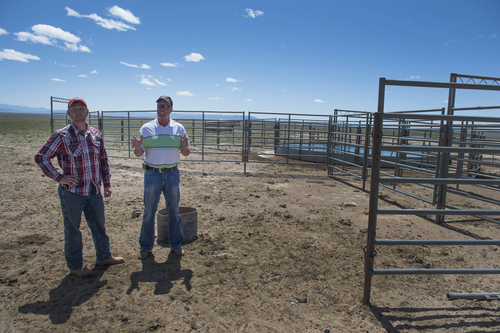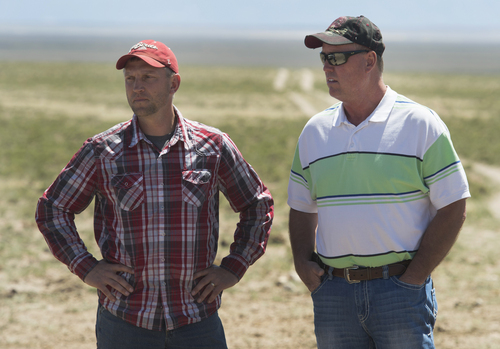This is an archived article that was published on sltrib.com in 2014, and information in the article may be outdated. It is provided only for personal research purposes and may not be reprinted.
Under pressure from ranchers and southern Utah elected leaders, the Bureau of Land Management's Utah office is fast-tracking proposed roundups of wild horses on the state's parched southwestern ranges.
In an environmental assessment posted Thursday on the BLM website, the agency said it wants to remove 607 horses this summer from the Bible Springs Complex northwest of Cedar City, an area now home to an estimated 777 horses but able to sustain only 170.
Utah BLM managers, according to an internal memo, also want to gather 400 horses from the Sulphur herd management area that stretches from northern Iron County, north along Beaver County's western border and into Millard County. That herd has exploded to about 718 horses, nearly three times as many as the 250 horses the BLM says the land can handle.
The "gather," as the BLM calls its roundups, is needed to protect the range from further degradation by wild horses, the document says. The BLM will take public comment for 30 days, but wants to be poised to round up the horses this summer — if it gets the go-ahead from Washington.
Environmental assessments typically take a year.
The agency had already announced there would be no roundups of wild horses in Western states this year, even though there are 14,000 more than the agency says the ecosystems can manage.
Nearly 50,000 wild horses removed from the West are living out their lives in Midwestern pastures, since congressional appropriations bills forbid euthanizing or slaughtering the horses.
Nonetheless, Utah's request is among proposals reportedly in the works to round up 6,000 of the excess wild horses in the West.
County commissions in Iron and Beaver County, heeding angry ranchers who have been asked by the BLM to cut their livestock grazing in half, had been threatening to round up the horses themselves in early April.
They've backed away from that plan because it is foaling season until July 1. They insist, however, that they'll begin removing horses in July if the BLM won't.
The counties' anger was fueled by the BLM's spending of millions of dollars to go after Nevada rancher Cliven Bundy's cattle for lack of payment — while it has not controlled the growing population of wild horses in southwestern Utah.
Estimates of the number of wild horses in Iron and Beaver counties vary widely, from 1,700 to several thousand. The BLM has set 601 as the maximum number of horses, spread across nine herd management areas in the two counties, that would keep the range healthy for all wildlife, cattle and for multiple uses.
On April 10, the counties and BLM agreed that they would try to capture some wild horses in temporary corrals on private property when the horses came in for a drink of trough water. Nearly three weeks later, however, not a single horse has been caught.
"It's actually very frustrating that we're getting really nowhere at this point," Iron County Commissioner David Miller said last week on a visit to the corral, erected around an existing cattle trough. It's located near what once was the town of Lund in northwestern Iron County.
"We're trying this first, which is what they [BLM officials] want to do," said Beaver County Commissioner Mark Whitney. But, he said, "I don't think they're going to work. The only way we're going to be able to catch these wild horses is a true, authentic roundup."
Whitney scoffs at suggestions there are fewer than 2,000 wild horses on the southwestern desert ranges. "I guarantee it's no less than 4,000 on the west desert," he says.
Jason Nicholes, a Utah Division of Wildlife Resources wildlife biologist, said he saw at least 1,500 wild horses while flying over the southwestern deserts this spring to count antelope. Could there be 2,000? "I believe it's getting close to that," Nicholes said.
A BLM spokeswoman, following directives from Washington in the wake of the Bundy case, declined to discuss horse numbers.
But it's clear from the new environmental assessment and internal memos from BLM Utah Director Juan Palma seeking permission to do roundups that the agency believes there will be roughly 1,800 on the range by summer.
Among the horses that would be rounded up are 151 at Blawn Wash in Beaver County, an area where wild horses are no longer supposed to graze. The main landowner there is the state of Utah.
Lou Brown, deputy assistant director of Utah's School and Institutional Trust Lands Administration, was happy to hear the BLM may finally act.
"We've written letter after letter to the BLM," Brown said. "It's supposed to be zeroed out and it never has been."
Any horse removals will help, he said. "With drought conditions in the west desert ... if something is not done, it's going to take years to recover."
The Wild Horse and Burro Act of 1971 makes it illegal for anyone except the BLM to capture a wild horse. But the counties weighing their own roundups are relying on a new, untested state law that they believe gives them the right to intervene when public health, safety or welfare is concerned.
The ranchers' livelihoods and the counties' economies, they say, are threatened by the BLM putting pressure on federal land grazing permit holders to cut their herds — or at least time spent on the range — in half. The agency asked for such voluntary cuts last fall.
It would be a big blow to the economies, said Randy Parker, chief executive officer of the Utah Farm Bureau Federation. He estimated $20 million in direct and indirect costs to the counties if those with federal grazing permits were forced to sell half their herds. An estimated 20,000 to 22,000 cattle now graze there at least part of the year.
Utah Gov. Gary Herbert last week said the states ought to take over management of the horse herds because the BLM has failed to do so — a suggestion that brought a rebuke from wild horse advocates.
"Governor Herbert is scapegoating wild horses for the damage to our public rangelands caused by livestock," said the American Wild Horse Preservation Campaign, a coalition of advocates.
In a letter to the governor, the coalition noted that the number of wild horses — and the acreage where they range — pales in comparison to the numbers of sheep and cattle and their grazing acreage.
The advocates urged Herbert to drop suggestions that Utah take over wild horse management.
Twitter: @KristenMoulton The public can comment through May 30 on the BLM's preliminary environmental assessment for a roundup of 607 horses in the Bible Springs Complex of Iron and Beaver counties. Written comments can be emailed to blm_ut_biblesprings@blm.gov or mailed to the BLM Cedar City Field Office (Office Manager), 176 E. DL Sargent Drive, Cedar City, UT 84721.







